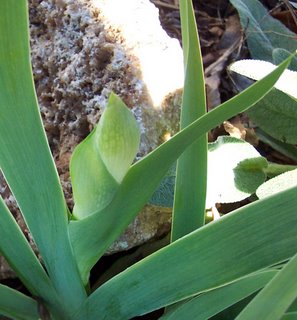[Cowtown Pattie has some good words about this Texas legend, and James of Austin has a good story, too.]
For the past week there’s been sniping among the weathermen [they seem to be all men], with some insisting that Austin should prepare for the coldest temperatures since the mid-1990’s, and others scoffingly sure we'd barely sustain a freeze. The latest prediction falls somewhere in the middle: a cold front bringing a hard freeze tomorrow night, followed by three nights in the twenties.

Philo and I went to the Lady Bird Johnson Wildflower Center last Saturday for the tree event, but we also looked at some paintings and strolled the paths.

One section of the garden celebrates the plant hunters and botanists who are remembered in the specific names of many native genuses. Austin gardeners who include Salvia greggii among their favorite plants can pay tribute to Josiah Gregg. Other plants with his name include Acacia greggii, Eupatorium greggii and Dalea greggii - those grey leaves surrounding the sign belong to Gregg's Dalea.
We didn't buy any trees, but we came home with several shrubs. That’s our new Evergreen sumac, Rhus virens, in the black container at the front.
 The mature specimens of sumac on the trails were quite beautiful. We'll do our best to help this shrub thrive, by planting it as recommended in a raised bed with decomposed granite added to the soil.
The mature specimens of sumac on the trails were quite beautiful. We'll do our best to help this shrub thrive, by planting it as recommended in a raised bed with decomposed granite added to the soil. There's a dwarf Nandina growing in the large terra cotta pot behind the sumac. Its leaves are green in summer, but the first cold snap turns them red, and they stay that way for months. So think twice before counting on dwarf green Nandinas as a green background for your flowers ... those ruby-red tones might screw up any spring color scheme using delicate pastel tones!
Look behind the Nandina for the Gardenia, subject of a July 14th post. That gardenia should probably go into the garage for the weekend.
 Our tall, white-flowering evergreen Abelias look unchanged after the ice, but not the one Abelia that blooms pale pink.
Our tall, white-flowering evergreen Abelias look unchanged after the ice, but not the one Abelia that blooms pale pink. The leaves on this Abelia still had medium green leaves in October, seen here with the stripes of Canna ‘Bengal Tiger’ in the background.
Now the canna is a cluster of brown stumps, and the Abelia leaves have responded to the ice by turning a sort of dark burgundy.

When the ice storm bent their tree branches, the result was so dramatic that the Loquat, Magnolia and Oleander got all the attention. They gradually rebounded, with some lost leaves, and a few branches that appear to be permanently bent. Philo thinks the ice actually improved the shape of Magnolia 'Little Gem'! But in the week following the freeze, everything didn't bounce back like these flexible evergreens.
Plants that usually grow easily here, some of them natives, gradually gave evidence that they may not be returning this spring. Every Salvia guaranitica, growing robustly in large stands around the yard, in different soils and various exposures, died down to the ground without leaving the usual tuft of green at the base, and the Pineapple sage doesn't look good. Texas native Tecoma stans, also called Esperanza or Yellow Bells, turned hard and brown, with no signs of life, and both Barbados Cherries look very bad. If any of the Cupheas, Durantas or Lantanas are alive, they’re hiding it well.
Although all the ice-covered Camellia flowers turned brown and mushy, the Camellia buds emerged from the ice to produce another set of blossoms.
 All the blue pansies in hanging baskets and containers lost open flowers, too, but in a few days they started blooming again. This colorful scene greets me every morning when I open the curtain - but what will I see on Monday?
All the blue pansies in hanging baskets and containers lost open flowers, too, but in a few days they started blooming again. This colorful scene greets me every morning when I open the curtain - but what will I see on Monday?
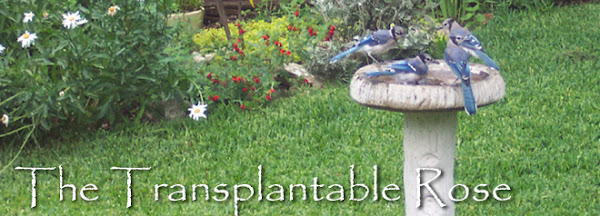













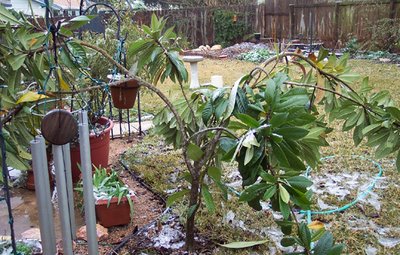 The Loquat leaves were still encased too, with most of the branches still bent. I experimented, holding a leaf and trying to slide off the ice, but it held on tight, so I left it to melt on its own.
The Loquat leaves were still encased too, with most of the branches still bent. I experimented, holding a leaf and trying to slide off the ice, but it held on tight, so I left it to melt on its own.  My darling Loquat is rebounding I think, although one limb is now completely horizontal, blocking the patio exit at eye level instead of arching 8 feet overhead as it did a week ago. Ki has advised me that props may be necessary, and if we're going to use the patio, at least this branch will need support.
My darling Loquat is rebounding I think, although one limb is now completely horizontal, blocking the patio exit at eye level instead of arching 8 feet overhead as it did a week ago. Ki has advised me that props may be necessary, and if we're going to use the patio, at least this branch will need support. 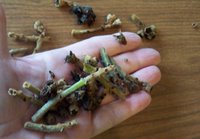
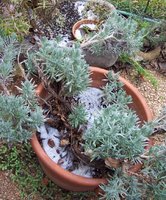
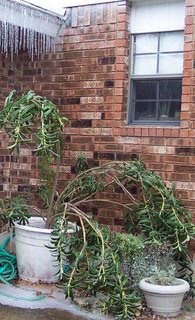






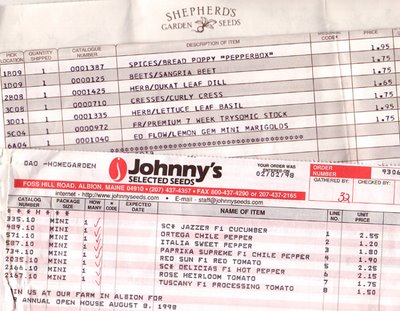 With this system, Philo grew interesting, hard-to-find varieties of tomatoes and peppers, and I was able to start perennials from seed, like Blackberry lilies, columbine, white coneflowers, Lychnis coronaria alba and splashy hardy Hibiscus.
With this system, Philo grew interesting, hard-to-find varieties of tomatoes and peppers, and I was able to start perennials from seed, like Blackberry lilies, columbine, white coneflowers, Lychnis coronaria alba and splashy hardy Hibiscus. 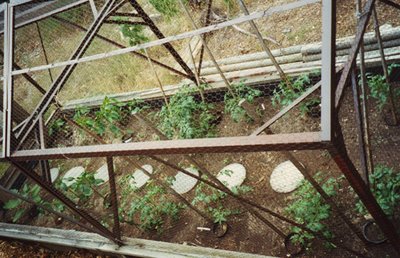

 In north Texas, we were stunned by the green fields on the side of IH35. We’ve never seen anything but browned plants there, whether we drove that stretch in winter’s cold, or summer’s heat. Maybe it's winter rye grass?
In north Texas, we were stunned by the green fields on the side of IH35. We’ve never seen anything but browned plants there, whether we drove that stretch in winter’s cold, or summer’s heat. Maybe it's winter rye grass?
